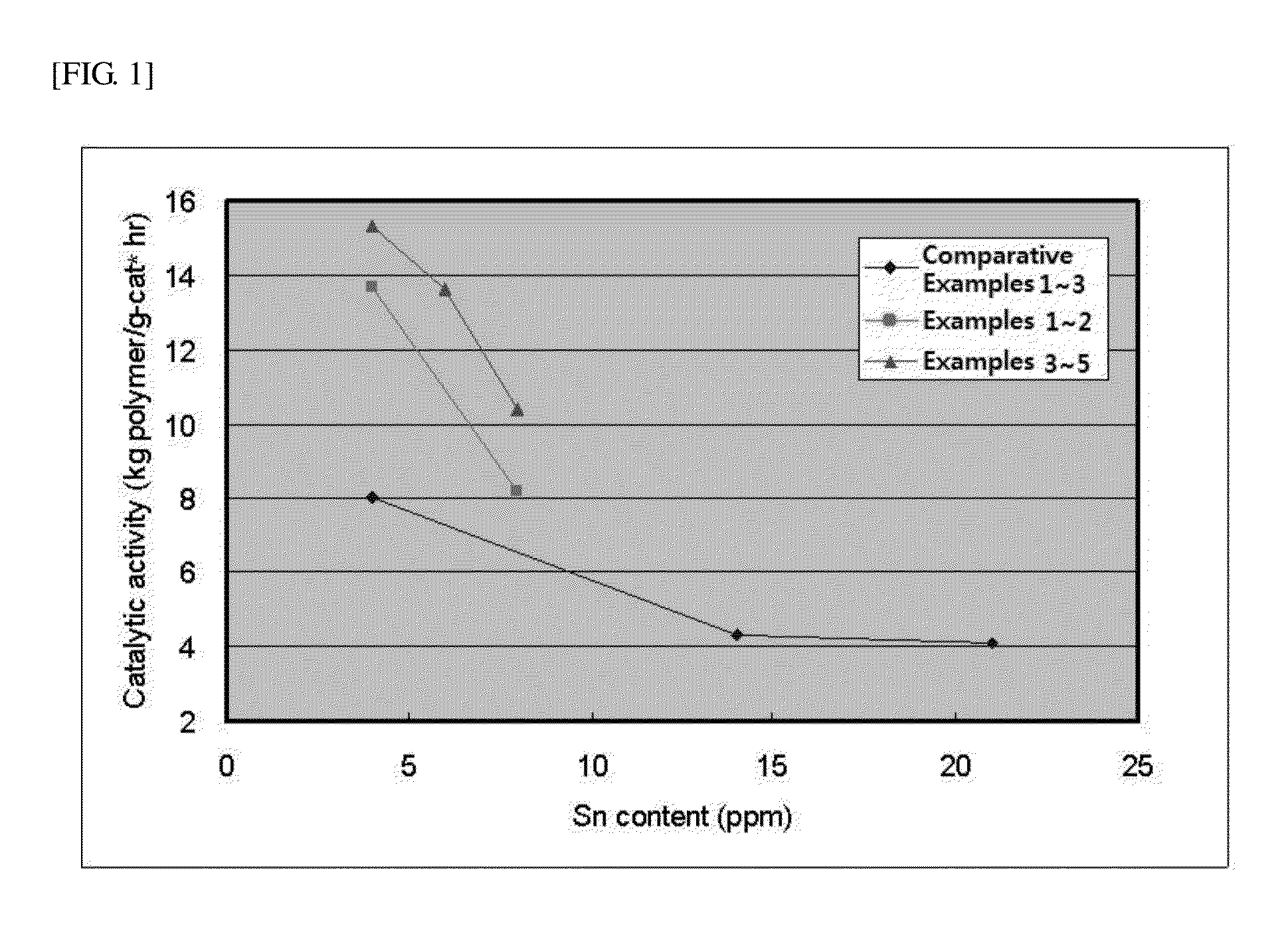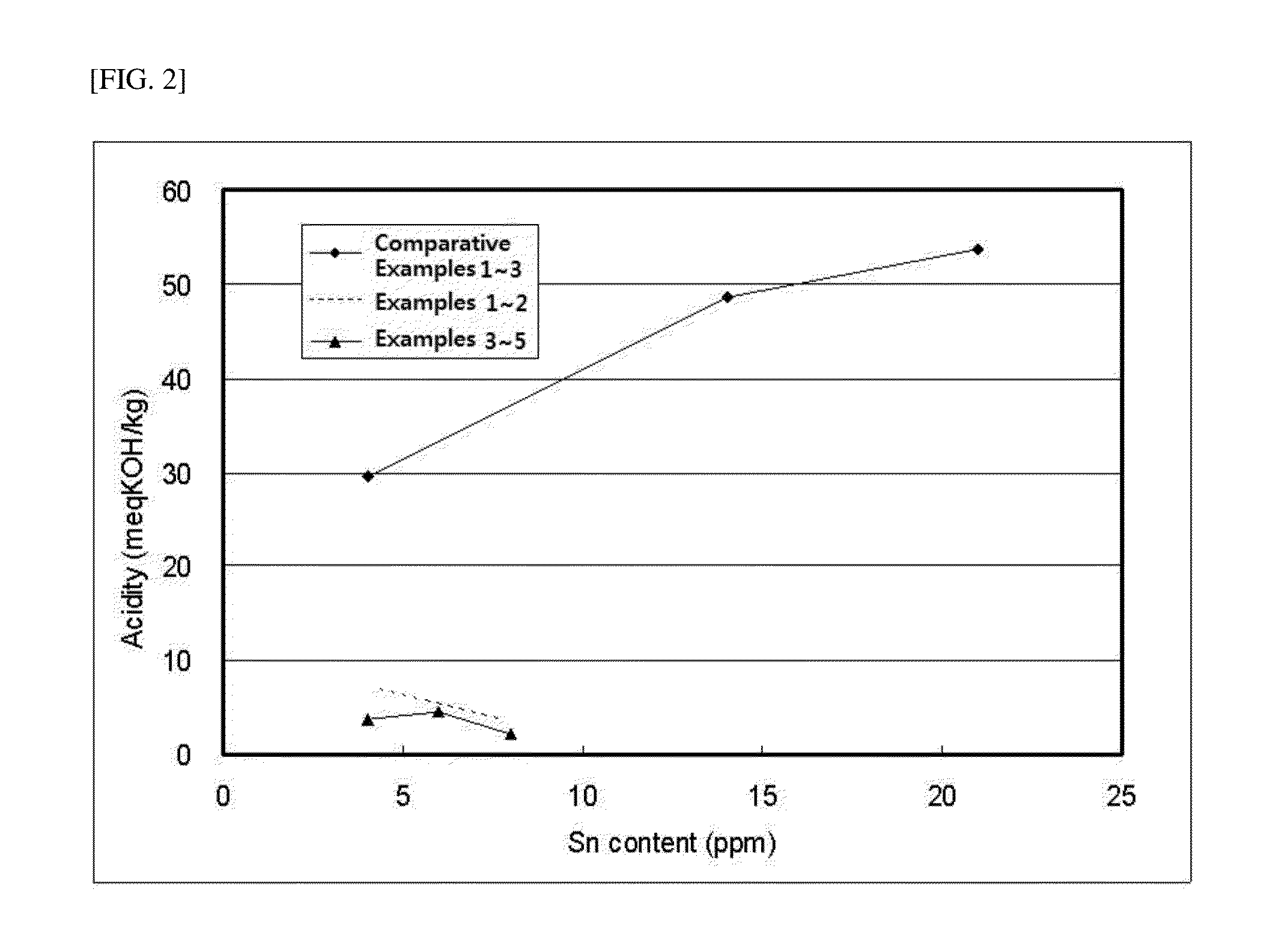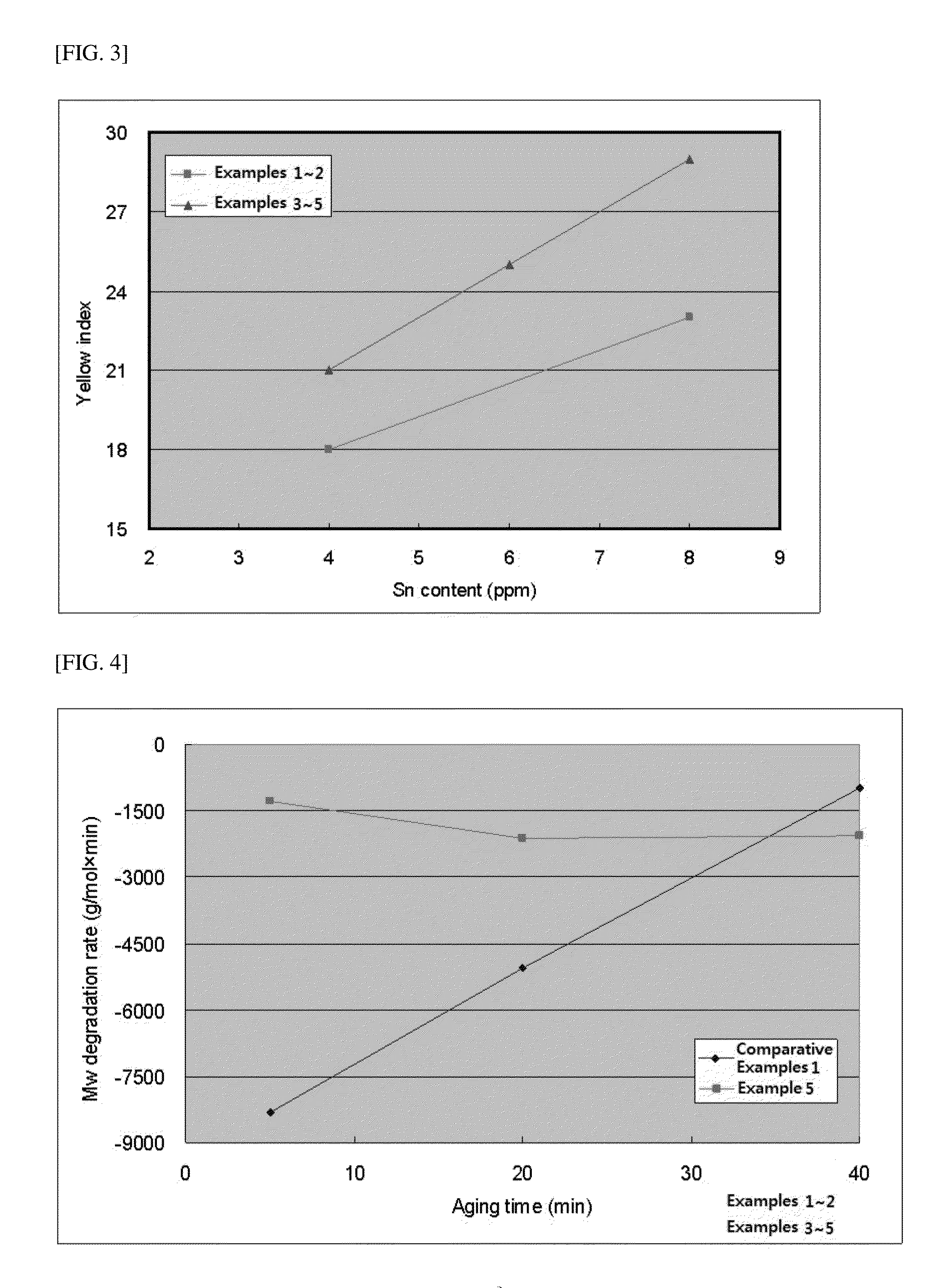Polylactide resin having excellent heat resistance and preparation method thereof
a polylactide resin and heat resistance technology, applied in the field of polylactide resins having excellent heat, can solve the problems of difficult to obtain polymers having a high, limited application, and resins tend to biodegrade, and achieve excellent mechanical properties, heat resistance, hydrolysis resistance, etc., and achieve high conversion rate. , the effect of excellent heat resistan
- Summary
- Abstract
- Description
- Claims
- Application Information
AI Technical Summary
Benefits of technology
Problems solved by technology
Method used
Image
Examples
example 1
[0122]Organic Carbodiimide-Sn(Oct)2 Complex / Lactide Ring Opening Polymerization
[0123](Polymerization Catalyst: a Mixture of Carbodiimide (0.05 Wt %) and Sn(Oct)2=1:100,000 mol / Lactide mol)
[0124]2 kg (13.8 mol) of solid-phase L-lactide monomer that was maintained at acidity of 50 meqKOH / Kg or less and at a moisture content of 200 ppm or less was injected into a 5 L-stirred tank reactor, and moisture and oxygen were sufficiently removed from the monomers and reactor under vacuum. Subsequently, as the initiator, 6.46 g (0.035 mol) of dodecanol (Sigma-Aldrich, Mw=186.34 g / mol), and as a polymerization catalyst, a mixture of 0.056 g (0.14 mmol, 1:100,000 mol / lactide mol) of Sn(Oct)2 (Sigma-Aldrich, Mw=405.1 g / mol) and 1 g of carbodiimide (Reine Chem, stabaxol P) were injected using a reactor charge port. After completing injection of the materials, the reactor was heated by heating hot oil. When the reactor temperature reached 100˜130° C., the reactor was stirred. Polymerization was perf...
example 2
[0125]Organic Carbodiimide-Sn(Oct)2 Complex / Lactide Ring Opening Polymerization
[0126](Polymerization Catalyst: a Mixture of Carbodiimide (0.05 Wt %) and Sn(Oct)2=1:200,000 mol / Lactide mol)
[0127]2 kg (13.8 mol) of solid-phase L-lactide monomer that was maintained at acidity of 50 meqKOH / Kg or less and at a moisture content of 200 ppm or less was injected into a 5 L-stirred tank reactor, and moisture and oxygen were sufficiently removed from the monomers and reactor under vacuum. Subsequently, as the initiator, 6.46 g (0.035 mol) of dodecanol (Sigma-Aldrich, Mw=186.34 g / mol), and as a polymerization catalyst, a mixture of 0.028 g (0.07 mmol, 1:200,000 mol / lactide mol) of Sn(Oct)2 (Sigma-Aldrich, Mw=405.1 g / mol) and 1 g of carbodiimide (Reine Chem, stabaxol P) were injected using a reactor charge port. After completing injection of the materials, the reactor was heated by heating hot oil. When the reactor temperature reached 100˜130° C., the reactor was stirred. Polymerization was perf...
example 3
[0128]Organic Carbodiimide-Sn(Oct)2 Complex / Lactide Ring Opening Polymerization
[0129](Polymerization Catalyst: a Mixture of Carbodiimide (0.1 Wt %) and Sn(Oct)2=1:100,000 mol / Lactide mol)
[0130]2 kg (13.8 mol) of solid-phase L-lactide monomer that was maintained at acidity of 50 meqKOH / Kg or less and at a moisture content of 200 ppm or less was injected into a 5 L-stirred tank reactor, and moisture and oxygen were sufficiently removed from the monomers and reactor under vacuum. Subsequently, as the initiator, 6.46 g (0.035 mol) of dodecanol (Sigma-Aldrich, Mw=186.34 g / mol), and as a polymerization catalyst, a mixture of 0.056 g (0.14 mmol, 1:100,000 mol / lactide mol) of Sn(Oct)2 (Sigma-Aldrich, Mw=405.1 g / mol) and 2 g of carbodiimide (Reine Chem, stabaxol P) were injected using a reactor charge port. After completing injection of the materials, the reactor was heated by heating hot oil. When the reactor temperature reached 100˜130° C., the reactor was stirred. Polymerization was perfo...
PUM
| Property | Measurement | Unit |
|---|---|---|
| Temperature | aaaaa | aaaaa |
| Temperature | aaaaa | aaaaa |
| Fraction | aaaaa | aaaaa |
Abstract
Description
Claims
Application Information
 Login to View More
Login to View More - R&D
- Intellectual Property
- Life Sciences
- Materials
- Tech Scout
- Unparalleled Data Quality
- Higher Quality Content
- 60% Fewer Hallucinations
Browse by: Latest US Patents, China's latest patents, Technical Efficacy Thesaurus, Application Domain, Technology Topic, Popular Technical Reports.
© 2025 PatSnap. All rights reserved.Legal|Privacy policy|Modern Slavery Act Transparency Statement|Sitemap|About US| Contact US: help@patsnap.com



